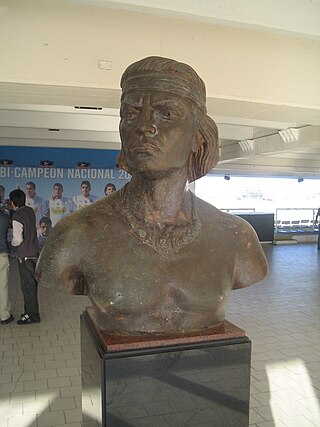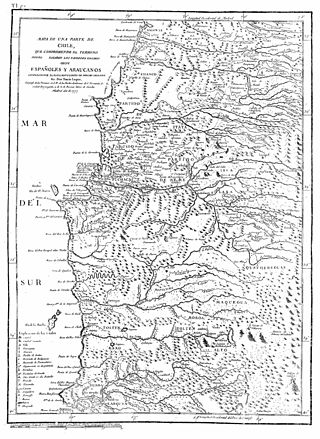Nangoniel was the Mapuche Toqui in 1585, and son of the previous toqui Cayancaru. He was the first Toqui to use cavalry with the Mapuche army.
Following the failure of his siege of Arauco, Cayancura, retired, leaving the command of the army to his son Nangoniel. He collected some infantry, and a hundred and fifty horse, which from then on began to be part of Mapuche armies. Nangoniel returned to invest the Arauco fortress again, and with his cavalry it became so closely invested, that the Spaniards were unable to supply it and were forced to evacuate it. Following this success he moved against the fort of Santísima Trinidad which protected the passage of Spanish supplies via the Bio-bio River but clashed with a division of Spanish troops, under Francisco Hernández, where he lost an arm and had other dangerous wounds. He retreated to a neighbouring mountain, where he was ambushed by a Spanish force and slain with 50 of his soldiers. The same day Cadeguala was proclaimed Toqui by the Mapuche army.

Lautaro was a young Mapuche toqui known for leading the indigenous resistance against Spanish conquest in Chile and developing the tactics that would continue to be employed by the Mapuche during the long-running Arauco War. Levtaru was captured by Spanish forces in his early youth, and he spent his teenage years as a personal servant of chief conquistador Pedro de Valdivia, but escaped in 1551. Back among his people he was declared toqui and led Mapuche warriors into a series of victories against the Spanish, culminating in the Battle of Tucapel in December 1553, where Pedro of Valdivia was killed. The outbreak of a typhus plague, a drought and a famine prevented the Mapuche from taking further actions to expel the Spanish in 1554 and 1555. Between 1556 and 1557, a small group of Mapuche commanded by Levtaru attempted to reach Santiago to liberate the whole of Central Chile from Spanish rule. Levtaru's attempts ended in 1557 when he was killed in an ambush by the Spanish.

Colocolo was a Mapuche leader in the early period of the Arauco War. He was a major figure in Alonso de Ercilla y Zúñiga's epic poem La Araucana, about the early Arauco War. In the poem he was the one that proposed the contest between the rival candidates for Toqui that resulted in the choice of Caupolicán. As a historical figure there are some few contemporary details about him. Stories of his life were written long after his lifetime and display many points of dubious historical accuracy.

Caupolicán was a toqui or war leader of the Mapuche people, who led the resistance of his people against the Spanish Conquistadors who invaded the territory of today's Chile during the sixteenth century. His rule as Toqui lasted roughly from 1553-1558 AD.

The Arauco War was a long-running conflict between colonial Spaniards and the Mapuche people, mostly fought in the Araucanía region of Chile. The conflict began at first as a reaction to the Spanish conquerors attempting to establish cities and force Mapuches into servitude. It subsequently evolved over time into phases comprising drawn-out sieges, slave-hunting expeditions, pillaging raids, punitive expeditions, and renewed Spanish attempts to secure lost territories. Abduction of women and war rape was common on both sides.

Toqui is a title conferred by the Mapuche on those chosen as leaders during times of war. The toqui is chosen in an assembly or parliament (coyag) of the chieftains (loncos) of various clans (Rehues) or confederation of clans (Aillarehues), allied during the war at hand. The toqui commanded strict obedience of all the warriors and their loncos during the war, would organize them into units and appoint leaders over them. This command would continue until the toqui was killed, abdicated (Cayancaru), was deposed in another parliament, or upon completion of the war for which he was chosen.

Pelantaro or Pelantarú was one of the vice toquis of Paillamachu, the toqui or military leader of the Mapuche people during the Mapuche uprising in 1598. Pelantaro and his lieutenants Anganamon and Guaiquimilla were credited with the death of the second Spanish Governor of Chile, Martín García Óñez de Loyola, during the Battle of Curalaba on December 21, 1598.
Ainavillo, Aynabillo, Aillavilu or Aillavilú, was the toqui of the Mapuche army from the provinces of "Ñuble, Itata, Renoguelen, Guachimavida, Marcande, Gualqui, Penco and Talcahuano." They tried to stop Pedro de Valdivia from invading their lands in 1550. He led about twenty thousand warriors in the surprise night attack on Valdivia's camp in the Battle of Andalien. After his defeat in that battle he gathered more warriors from the allied regions of Arauco and Tucapel, south of the Bio-Bio River, for an attack on Valdivia's newly constructed fort of Concepcion at what is now Penco. Leading an army of sixty thousand warriors in three divisions against the fort in the Battle of Penco. Ainavillo's command that had been previously defeated at Andalien, was recognized by the Spaniards and Valdivia picked it out for a vigorous charge by all their cavalry following a softening up by volleys of their firearms. It was broken at the first onslaught and fled with the Spanish in pursuit, followed by the retreat of the other two divisions of the Mapuche upon seeing the spectacle.
The Battle of Penco took place on March 12, 1550, between 60,000 Mapuche under the command of their toqui Ainavillo with his Araucan and Tucapel allies and Pedro de Valdivia's 200 Spaniards on horse and afoot with many yanakuna including 300 Mapochoes auxiliaries under their leader Michimalonco, defending their newly raised fort at Penco. It was part of the Arauco war.

The Conquest of Chile is a period in Chilean historiography that starts with the arrival of Pedro de Valdivia to Chile in 1541 and ends with the death of Martín García Óñez de Loyola in the Battle of Curalaba in 1598, and the destruction of the Seven Cities in 1598–1604 in the Araucanía region.
Caupolicán the Younger according to Juan Ignacio Molina was the son of the toqui Caupolicán. He was made toqui following the capture and execution of his father in 1558. He continued the first Mapuche rising against the Spanish conquistadors in 1558 and commanded the Mapuche army in constructing a pukara at Quiapo to block García Hurtado de Mendoza from rebuilding a fort in Arauco completing the chain of forts for suppression of their rebellion. In the Battle of Quiapo the Mapuche suffered a terrible defeat and there Caupolicán the younger died. His successor as toqui was Illangulién.
The Battle of Lagunillas was a battle in the Arauco War on November 8, 1557, between the army of García Hurtado de Mendoza and the Mapuche army near some shallow lakes a league south of the Bio-Bio River.
Cadeguala or Cadiguala was a Mapuche toqui elected in 1585 following the death in battle of the previous toqui Nangoniel. Cadeguala was a noted warrior and the first Mapuche toqui known to have used cavalry successfully in battle. He was killed in a duel with the garrison commander of the Spanish fort at Purén in 1586.
Cayancura, or Cayeucura, was a Mapuche leader native to the region of Marigüenu, chosen as toqui in 1584 to replace the captured Paineñamcu. His one great operation was an attempted siege of the fort at Arauco that failed, leading to his abdication of his office in favor of his son Nangoniel in 1585.
Vilumilla was the Mapuche Toqui elected in 1722 to lead the Mapuche Uprising of 1723 against the Spanish for their violation of the peace.
Millalelmo or Millarelmo was a Mapuche military leader in the second great Mapuche rebellion that began in 1561 during the Arauco War. Probably the toqui of the Arauco region, he commanded the Mapuche army of that area at the siege of Arauco from May 20 to June 30, 1562.
Pedro de Avendaño a Spanish soldier that had arrived in Chile with the army of García Hurtado de Mendoza in 1557. He distinguished himself in the Battle of Millarapue. He later served in the garrison of Cañete under captain Alonso de Reinoso. Reinoso eventually found an Indian who betrayed the location of the fugitive Mapuche toqui Caupolicán. Avendaño, with 50 men and the traitorous Indian as a guide, marched in stormy weather into the mountains to Pilmaiquén and captured Caupolicán as he was planning a new counter-offensive against the Spanish, near the modern Antihuala, on February 5, 1558. He brought the toqui back to Cañete where he was eventually executed by impalement at the order of corregidor Reinoso.
Turcupichun was the toqui of the Mapuche Aillarehues in the vicinity of Concepcion, Chile and the Bio-Bio River valley from 1557 to 1558. García Hurtado de Mendoza landed in early June 1557 on the island of La Quiriquina at the mouth of the bay of San Pedro. Soon afterward he sent out messengers to the local Aillarehues to come and submit to the Spanish. Turcupichun gathered them in a great coyag where he advocated resistance to the death and elected him as their toqui replacing the dead Lautaro.
Guanoalca was the Mapuche toqui (leader) elected in 1586 following the death in battle of the previous toqui, Cadeguala, killed in a duel with the garrison commander of the Spanish fort at Purén in 1586. He returned to continue the siege and forced the Spanish to evacuate the fort, which he then destroyed.
Quepuantú was an indigenous Chilean Moluche toqui in the 17th century. He was known for his leadership in the Arauco War and succeeded Butapichón in commanded the Mapuche army against the Spanish as Toqui, from 1631 to 1632. On January 13, 1631 he commanded the Mapuche army with Butapichón against Spanish forces led by the very competent Governor Francisco Laso de la Vega who defeated them in the pitched battle of La Albarrada. He died in 1632 in a duel with the cacique Loncomilla, his rival for dominance in the command of his tribe. Butapichón succeeded him as Toqui for a second time from 1632 to 1634.
The Mapuche uprising of 1655 was a series of coordinated Mapuche attacks against Spanish settlements and forts in colonial Chile. It was the worst military crisis in Chile in decades, and contemporaries even considered the possibility of a civil war among the Spanish. The uprising marks the beginning of a ten-year period of warfare between the Spanish and the Mapuche.






